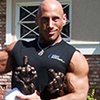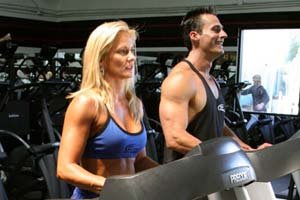
Important Concepts & Definitions

 Maximal Heart Rate:
Maximal Heart Rate:
The Maximal Heart Rate is a number related to your age. As we grow older, our hearts start to beat a little more slowly, therefore your Maximal Heart Rate changes as well. To estimate your Maximal Heart Rate, subtract your age from the number 220.

 Target Heart-Rate Zone:
Target Heart-Rate Zone:
Your Target Heart-Rate Zone is the number of beats per minute (bpm) at which your heart should be beating during aerobic exercise. For most healthy individuals, this range is approximately 50 to 80 percent of your Maximal Heart Rate. So, if your maximal heart rate is 160 bpm, the low end of the range (50 percent) would be 80 bpm, and the high end of the range (80 percent) would be 128 bpm.
Your Target Heart-Rate Zone is a guideline - an indicator of how hard you should be exercising. It is important to note that the Target Heart-Rate Zone is recommended for individuals without any health problems and that prior to starting any exercise plan, especially a cardiovascular exercise plan individuals should proceed slowly.
Related Cardio Articles:
Those with a history of certain health problems within their families and those taking medication that alter the heart rate should consult their physician prior to staring such an exercise regime, and should receive physician clearance regarding the appropriate exercise intensity.

Why Monitor Your Heart Rate?
When you exercise, your heart beats faster to meet the demand for more blood and oxygen by the muscles of the body.
The more intense the activity, the faster your heart will beat. Therefore, monitoring your heart rate during exercise can be an excellent way to monitor exercise intensity.
To get the most out of exercise, you should monitor your intensity throughout your workout and maintain your heart rate within your heart rate training zone. By doing so you can ensure that you get an effective workout without risk of injury, or worse to your heath.
Related Injury Articles:

 Starting A Cardiovascular Exercise Program:
Starting A Cardiovascular Exercise Program:
Those just beginning an aerobic exercise program should start their program slowly and aim for the low end of the zone. Intensity can be slowly increased as you become more comfortable with the workouts.

 Determining What End Of The Target Heart-Rate Zone Is The Most Beneficial:
Determining What End Of The Target Heart-Rate Zone Is The Most Beneficial:
At what end of the Target Heart-Rate Zone you want to maintain will depend on your fitness goals.
For people who are more fit, or are training for competitive events, or just looking to maximize gains from their workout (be it cardiovascular fitness or weight loss) may want to aim for the higher end of the zone.
For people who are looking to maximize fat loss, while maintaining muscle mass - operating at approximately 60-65% of their Maximal Heart Rate is recommended.
A simple rule of thumb for operating in this range is to use the "Talk Test". What the "talk test" means is simply that you should be able to carry on a conversation during your workout. If you are to do this you are most probably in the (approximately) 60-65 of your Maximal Heart Rate (assuming that you are not lollygagging).
Remember, if your goal is to burn fat and you are breathless, or can't talk, you're working too hard and should slow down.

 How To Monitor:
How To Monitor:
Accurate pulse-count assessment is crucial when monitoring exercise intensity. By using the first two fingers of one hand and locating the artery, a pulse rate can be easily determined.
If you do not have a fancy electronic monitor, it is very easy to monitor your maximum Heart Rate and determine your Target Heart Rate Zone.
Although there are a number of "sites" that can be used to monitor your heart (or pulse rate) the two most convenient sites often used the carotid pulse at the side of the neck and the radial pulse located at the base of the thumb of either hand.
Immediately after exercise:
- Isolate your pulse.
- Count the number of beats in a 10-second period.
- Multiply the number of beats per 10 seconds by six.
- This will determine the heart rate in beats per minute.
Always check your pulse frequently throughout your workout to make sure you're within your target heart rate zone.
| FORUM THREAD | |||
|
Started By: GW-LAX |

 Tying Everything Together:
Tying Everything Together:
Example
If a 10-second pulse count were 22, then the heart rate would be 132 bpm.
So, lets put this example to work.
Lets say you are 20 years old and looking to exercise to maximize fat burning...
To estimate your Maximal Heart Rate, subtract your age from the number 220 (which in this case would be 220-20 = 200). Then multiply this number, 200 by .65 ( 65% of the target heart rate zone) which equals 130 bpm, your optimum target heart rate zone to maximize fat burning while minimizing the burning of lean muscle.

A Final Word About Heart-Rate Monitoring
Remember, your estimated target heart-rate zone is an estimate.
How you use this information depends upon your exercise goals.
If you are looking to maximize aerobic fitness you should aim to operate at the higher end of your Maximal Heart Rate (70-80%). If you are looking to maximize fat loss, while maintaining muscle mass - operating at approximately 60-65% of their Maximal Heart Rate is recommended.
It is very important to remember to pay attention to your body. If you feel like you are exercising too hard, you probably are. Also, keep in mind that dizziness and lightheadedness is not a good sign and if you experience these, you are overexerting yourself and should stop!
The best advice is to reduce your intensity and find a heart-rate range that works for you.





